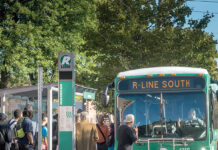
NORTH KINGSTOWN – Gov. Gina M. Raimondo on Wednesday set a new clean energy goal for the state, calling for 1,000 megawatts of renewable energy generation by 2020.
The state now counts about 138 megawatts of clean energy generated in the Ocean State, ranging from Deepwater Wind LLC’s 30-megawatt offshore wind farm to small-scale solar projects atop the sunnier parts of residential and commercial landscapes and rooftops.
Raimondo made the announcement at Quonset Development Corp., which is working on a new 400,000-square-foot solar array and has plans for another land-based array on Davisville Road.
“Every step we take toward a clean-energy future is a step toward a stronger, more sustainable environment and economy,” Raimondo said in prepared remarks.
The state expects the growth to be realized by more wind and solar projects cropping up across the private, public and residential sectors. And the goal runs in concert with her push to double the number of Rhode Islanders working in clean-energy sector also by 2020.
The goal, however, falls short of including any mandating legislation. The goal itself is encouraging to renewable-energy advocates, including Rep. Aaron Regunberg, D-Providence, but without a clear plan for how to get there, it falls a little short.
“When I heard about it I was like, ‘That’s great. Ambitions goals are great to set tones,’ ” Regunberg said. “[However], a goal is just a goal, and right now we’re not on pace to take renewable generation to that scale. We need to actually do some things to reach that goal and get on pace.”
The 1,000-megawatt goal without mandates doesn’t quite carry the same weight as efforts seen in other states, including Massachusetts where Gov. Charlie Baker in August signed a law requiring utilities, including National Grid PLC, to purchase up to 1,600 megawatts of offshore wind over the next decade. The law will most likely grow the industry because offshore wind companies know they can lock into the ever-important financing of long-term energy contracts with utilities.
Regunberg, who championed net-metering legislation in the House last year, is looking to expand on the initiative this year, and allow nonprofits and educational facilities to take advantage of the solar power opportunity. He also hopes to garner enough support to pass a carbon-tax law, which is often considered in Statehouses across the country, but rarely passed. The tax would effectively increase the cost of fossil fuel, making clean energy more economically attractive for individuals and businesses.
“We need to, and should pass it now if we’re going to meet these goals,” he said.
Raimondo’s office points to the governor’s support of virtual net-metering, expansion of clean energy bonds and reduction of energy consumption as examples of her commitment to renewable energy. The state also has clean energy initiatives, including the Renewable Energy Growth program and the Renewable Energy Fund, designed to encourage the growth of clean energy projects.
And Raimondo predicts clean-energy generation should grow as associated costs continue to fall with the advancement of technology, saying “an affordable clean energy future is no longer simply a dream.”
Correction: An earlier version of this story misstated the state’s current clean-energy capacity.













Love it – Go Rhode Island!